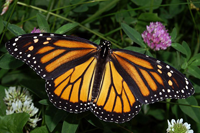Yearly Migration of the Monarchs
Parts of California play host each year to migrating masses of monarch butterflies that pass a number of months in protected groves, inspiring and astounding naturalists of all ages. The science behind butterfly migration is especially fascinating when you take into account that most butterflies live less than two months!
Yearly butterfly migration provides opportunity for a fluttering science outing for naturalists of all ages. Don't forget your binoculars!
Inspiring Exploration
To supplement or spark a class or family science investigation, students interested in butterflies, migration, or zoology may enjoy:
From those who carry a birding life list and compare the focal length of their binoculars to those who peer from a living room window with a pocket bird guide nearby, birdwatchers of all persuasions know that birds come and go throughout the year. There may be some birds resident throughout the year. You may see Pygmy Nuthatches, for example, even in snowy winter trees, and Northern Cardinals tend to stay put. But many birds appear, only briefly, at certain times of the year. It may seem like clockwork that the Cedar Waxwings and American Robins make an appearance in January or that a backyard Calliope Hummingbird departs from your well-kept feeder in late August. Similarly, you may hear someone talk about the return of the American Goldfinches, the first appearance of a Western Tanager, or the departure of the Great Blue Herons, depending on your location. This sensation of coming and going is especially true for birders who live in regions with extreme winter climates or with temperate climates that provide wintering grounds for transient species.
The mysteries of bird migration, and the ways in which they navigate travels of long distances to arrive, year after year, in the same locations, fascinate zoologists. But birds are not the only creatures that migrate or "move" from one location to another during a year.
Flights of Fancy
In parts of California, the winter months offer peak viewing of monarch butterflies. These regal orange and black butterflies travel south during late summer and wait out the winter in protected eucalyptus groves in places like Fremont and Monterey. So many monarchs arrive in Pacific Grove in Monterey County each year, staying between October and February, that the city has dubbed itself "Butterfly Town, U.S.A." In addition to local mandates and fines against harming a butterfly, and an annual butterfly parade, Pacific Grove has trained butterfly docents and a dedicated butterfly sanctuary where visitors can walk through and be amazed by the fluttering of thousands of butterflies high above in the canopy of trees.
A Monarch's Genetics
The butterflies that make the annual migration to California are referred to as the "fourth generation" of monarchs in a year. Monarchs born to the first three generations have a life span of only two to six weeks. The fourth and final generation, however, makes the migration, hibernates in a protected and warmer area, and then returns in the spring to mating and breeding grounds in the North and East to lay eggs on milkweed plants. From the eucalyptus groves to the milkweed-rich habitats, the cycle of migrating monarchs repeats, year after year, beginning with the return of the fourth generation butterflies that lay the eggs representing the first generation of a new year. That the butterflies that make the yearly trek to California or Mexico are four generations removed from the ones who made the trip the previous year is a mindboggling reality and adds to the aura and mystique of these fluttering orange and black insects. With no "veteran" traveler (or parent with firsthand knowledge of migration) to tell them when and where to go, how do they know? What kind of genetic imprinting provides the map for migration? How do the monarchs determine when to leave and when to return?
Making Connections
Unless you have a grove of eucalyptus—or milkweed—in your backyard, your monarch spotting will likely be at a sanctuary as a tourist outing or during the breeding season when monarchs cluster to habitats thriving with milkweed, a plant critical to monarch breeding and to the survival of newly hatched larvae. The larvae feed only on milkweed—and lots of it! In the two weeks before the larvae enters the pupa stage, the larvae grows to an estimated 2,700 times its original size (molting multiple times in the process). What would happen if the milkweed patches the monarchs return to each year disappeared?
While planting certain flowers, or your own row of milkweed bushes, might draw more butterflies to your backyard during spring months, students can more easily explore the role of food source and food preference by experimenting with the eating habits of neighborhood birds. The following Project Ideas help students investigate the relationship between birds and a food source:
- What Seeds Do Birds Prefer to Eat?: Backyard birders know that different birds eat different types of seed and may stock feeders with certain kinds of seed or seed blends in hopes of cultivating a specific group of feathered friends. (The type of bird feeder you use may also make a difference in which birds stop by!) If you are new to watching birds in your area, you can put seed preference to the test in this zoology Project Idea. This project, perfect for family, classroom, or independent science exploration, involves building a four-part feeder that makes it easy to monitor the types of seeds your local birds like best.
With a bit of innovation, students and classes can easily modify and extend this investigation. The partitioned feeder described in the Project Idea keeps the different types of seeds all in proximity of one another. Birds choose, cafeteria-style, what to eat. How would bird activity and behavior change if you used multiple feeders, separate feeders at different locations, each with different types of seed? What might happen if you rotate the seed in the feeders routinely throughout the investigation so that the location of each seed changes?
- How Sweet It Is! Explore the Roles of Color and Sugar Content in Hummingbirds' Food Preferences.: Hummingbirds are adept at finding the sweetest flowers as food sources. Often their selections appear to be the most brightly colored of flowers. Do hummingbirds make a correlation between sweetness and visible color and choose their food sources based on the color? In this zoology science fair project, you can put this question to the test. Which is more important, the color of the food source or the concentration of sugar? Typical backyard hummingbird feeders are filled with a clear solution, but the feeder is often made so that it appears a certain color. In this project, you will create multiple feeders, each with different colors of syrupy hummingbird solution. After testing to see which color your backyard hummingbird favors, you can experiment with the sugar ratio in the different cups to see what happens. Not only will you learn a lot about hummingbird behavior and adaptation, but you may find that your garden needs a certain color of hummingbird feeder, regardless of your own favorite color palette!
- With a Little Bread as Bait, Can You Make a Bird Migrate?: Changes in the location and availability of a food source may force changes in migration patterns. In this zoology Project Idea, students put this idea to a hands-on test on a small scale, at a single outdoor location. After initially feeding birds in two different parts of a large outdoor area (like a park), students can investigate to see what happens when the availability of food in one location changes. How long will it take for the birds to find the other food source?
- Here Today, Gone Tomorrow: Saving Migratory Animals: Changes to natural habitats caused by urban expansion can be devastating. When a species only uses a habitat part of the year, it can be easy to overlook or underestimate the impact of urban development and engineering. This science project challenges students to think about the relationship between migration and society and development. What happens when a migrating bird's wintering grounds suddenly disappear? In the case of the butterflies, what would happen if the monarchs arrived in October to find their eucalyptus sanctuary had been replaced by an apartment building? Or, on the flip side, what if the monarch's milkweed breeding grounds were plowed and replaced during the months the monarchs are absent? In this environmental science Project Idea, students use online Movebank data to investigate the habitats and stopover destinations involved in the movement or migration of an individual bird. This project helps students better understand the many locations that may be critical to a species' survival, even if the bird only spends a short time each year in a given place.
First-hand Science
Observing bird and butterfly behavior raises many questions about how they survive, particularly given their unique generational cycles, the importance of their yearly treks, and the specific requirements of their breeding grounds. If you have the opportunity to see the wintering monarchs, it is a sight worth seeing! And if you are curious about animal movement and migration in general, there are many Project Ideas at Science Buddies that enable students to explore further. You can get started by reviewing the roundup in the "Birds on the Move" blog post, and don't miss this student's story about tracking wolf movement.
Categories:
You Might Also Enjoy These Related Posts:
- Plastics and Earth Day - Science Projects
- Arduino Science Projects and Physical Computing
- 10+ Robotics Projects with the BlueBot Kit
- 5 STEM Activities with Marshmallow Peeps
- March Madness Basketball Science Projects: Sports Science Experiments
- Women in STEM! More than 60 Scientists and Engineers for Women's History Month
- Explore Artificial Intelligence and Machine Learning with Student AI Projects
- 10 Reasons to Do the Rubber Band Car Engineering Challenge










